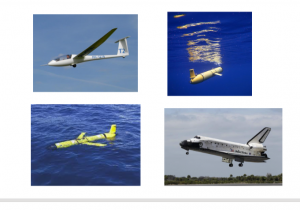Mathematical Modeling and Kinematics of a Glider
Alex Gale; Kwan Jie Lee; Angela Lee; and Lucas Minet

Note: Click on image to see PowerPoint presentation
Summary
Under water gliders are free-swimming robotic vehicles that gather conductivity-temperature-depth (CTD) data from the ocean for months at a time and transmits the data in real time via satellite telemetry. Studies using gliders have important applications in oceanography, engineering, and remote sensing. Here we employ mathematical models for studying the flightpath of a glider using vector valued functions. We use these models to calculate the osculating plane of the glider. The model parameters are optimized to minimize turbulence. We studied the kinematics of a glider using reported real time GPS data. We analyzed the reported glider velocity data and used vector-calculus based methods to derive the instantaneous and average velocities and acceleration vectors. We apply matrix-algebra based methods to translate and rotate the glider to position it at appropriate coordinates underwater for gathering data. This research involves mathematical modeling of real-world data, applied optimization, and data visualization. These studies provide novel avenues for hands on exploration and application of key mathematical concepts.


